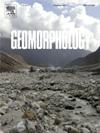A decade of erosion monitoring of coastal chalk cliff faces at a seasonal frequency (2010−2021) using terrestrial lasergrammetry and photogrammetry (Varengeville-sur-Mer and Dieppe, Normandy, France): Technical evolution and main results
IF 3.1
2区 地球科学
Q2 GEOGRAPHY, PHYSICAL
引用次数: 0
Abstract
Every four to five months between October 2010 and July 2021, cliff face topography was monitored with centimeter-scale precision at two sites in Normandy, each with a chalk cliff linear length of several tens to hundreds of meters. These sites (6.5 km apart as the crow flies) have relatively similar lithological and meteorological contexts (the latter is affected by seasonal variations of oceanic temperate climate) but are affected differently by marine agents: Varengeville-sur-Mer is an active cliff (influenced by both marine and subaerial factors), while Dieppe is an abandoned cliff (affected only by subaerial factors). Thanks to our seasonal monitoring using terrestrial lasergrammetry and then terrestrial photogrammetry, our main outcomes are: 1) the cliff face erosion rate (2010–2021) is approximately 50 times higher in the active cliff context than in the abandoned one (0.51 ± 0.02 m/year and 0.00 ± 0.01 m/year, respectively), reinforcing the importance of marine actions in the erosion of Norman chalk cliffs; 2) unsurprisingly, along the active cliff, erosion peaks generally occur in winter, with periods of stability preferentially in summer; 3) in Varengeville-sur-Mer, of the 103 gravity movements identified on the cliff face, rock falls accounted for 68 % of total erosion, compared with 32 % for debris falls, the latter value being higher than reported in the scientific literature (from 2 to 25 %); 4) nine cases of cliff foot departure generating a basal notch, which later triggered rock falls over the entire cliff face by instability propagation in Varengeville-sur-Mer, have been identified. This monitoring continues, providing a valuable database for understanding cliff erosion (rates, rhythms, and modalities).
2010 年 10 月至 2021 年 7 月期间,每隔四到五个月,在诺曼底的两个地点对崖壁地形进行厘米级精度的监测。这两个地点(相距 6.5 公里)的岩性和气象环境相对相似(后者受海洋温带气候季节变化的影响),但受海洋介质的影响却不同:Varengeville-sur-Mer 是一个活跃的悬崖(同时受到海洋和陆下因素的影响),而 Dieppe 则是一个废弃的悬崖(只受到陆下因素的影响)。通过使用陆地激光测距仪和陆地摄影测量仪进行季节性监测,我们取得了以下主要成果1) 活动悬崖的崖面侵蚀率(2010-2021 年)比废弃悬崖高出约 50 倍(分别为 0.51 ± 0.02 米/年和 0.00 ± 0.01 米/年)。01 米/年),这说明海洋作用对诺曼白垩系悬崖侵蚀的重要性;2)不难理解的是,在活动悬崖上,侵蚀高峰一般出现在冬季,而稳定期则在夏季;3)在 Varengeville-sur-Mer,在崖壁上发现的 103 次重力运动中,岩石崩落占侵蚀总量的 68%,而碎石崩落占 32%,后者的数值高于科学文献中的报道(从 2%到 25%不等);4)在 Varengeville-sur-Mer,已经发现了九例崖脚离开产生基底缺口的情况,这些缺口后来通过不稳定性传播引发了整个崖壁上的岩石崩落。这种监测仍在继续,为了解悬崖侵蚀(速度、节奏和方式)提供了宝贵的数据库。
本文章由计算机程序翻译,如有差异,请以英文原文为准。
求助全文
约1分钟内获得全文
求助全文
来源期刊

Geomorphology
地学-地球科学综合
CiteScore
8.00
自引率
10.30%
发文量
309
审稿时长
3.4 months
期刊介绍:
Our journal''s scope includes geomorphic themes of: tectonics and regional structure; glacial processes and landforms; fluvial sequences, Quaternary environmental change and dating; fluvial processes and landforms; mass movement, slopes and periglacial processes; hillslopes and soil erosion; weathering, karst and soils; aeolian processes and landforms, coastal dunes and arid environments; coastal and marine processes, estuaries and lakes; modelling, theoretical and quantitative geomorphology; DEM, GIS and remote sensing methods and applications; hazards, applied and planetary geomorphology; and volcanics.
 求助内容:
求助内容: 应助结果提醒方式:
应助结果提醒方式:


